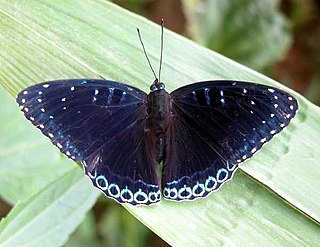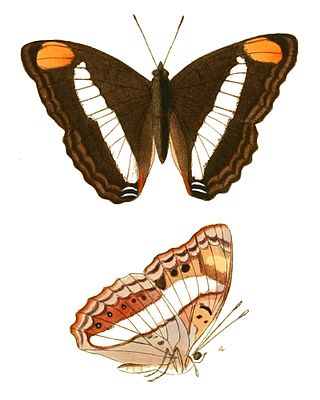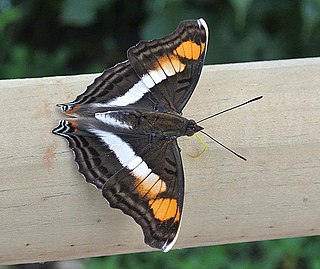An emperor is a type of monarch.

The Nymphalidae are the largest family of butterflies, with more than 6,000 species distributed throughout most of the world. Belonging to the superfamily Papilionoidea, they are usually medium-sized to large butterflies. Most species have a reduced pair of forelegs and many hold their colourful wings flat when resting. They are also called brush-footed butterflies or four-footed butterflies, because they are known to stand on only four legs while the other two are curled up; in some species, these forelegs have a brush-like set of hairs, which gives this family its other common name. Many species are brightly coloured and include popular species such as the emperors, monarch butterfly, admirals, tortoiseshells, and fritillaries. However, the under wings are, in contrast, often dull and in some species look remarkably like dead leaves, or are much paler, producing a cryptic effect that helps the butterflies blend into their surroundings.

The Pieridae are a large family of butterflies with about 76 genera containing about 1,100 species, mostly from tropical Africa and tropical Asia with some varieties in the more northern regions of North America and Eurasia. Most pierid butterflies are white, yellow, or orange in coloration, often with black spots. The pigments that give the distinct coloring to these butterflies are derived from waste products in the body and are a characteristic of this family. The family was created by William John Swainson in 1820.

A proboscis is an elongated appendage from the head of an animal, either a vertebrate or an invertebrate. In invertebrates, the term usually refers to tubular mouthparts used for feeding and sucking. In vertebrates, a proboscis is an elongated nose or snout.

The hymenopteran family Scelionidae is a very large cosmopolitan group of exclusively parasitoid wasps, mostly small (0.5–10 mm), often black, often highly sculptured, with (typically) elbowed antennae that have a 9- or 10-segmented flagellum. It was once considered to be a subfamily of the Platygastridae, but has been revived in the most recent classification of Platygastroidea.

Adelpha californica, the California sister, is a species of butterfly in the family Nymphalidae. They are common in California, but can also be found in western Nevada and Oregon, as well as in northern Baja California. The upper surfaces of their wings are dark brown to black with wide cream white bands dissecting both wings and two orange patches near the tips of the forewings. The underside is variously colored with browns, blue, orange, and white. A. californica is unpalatable to predators and is part of a large mimicry complex.

Doxocopa is a genus of Neotropical butterflies in the family Nymphalidae, subfamily Apaturinae. It includes the following species:

Sephisa is a genus of butterflies in the family Nymphalidae. It is related to Apatura, Hestinalis, and Mimathyma, with a common ancestor that diverged around 30Ma.

Hestinalis is a genus of butterflies in the family Nymphalidae. Some authors consider Hestinalis and Hestina as one genus.

Asterocampa celtis, the hackberry emperor, is a North American butterfly that belongs to the brushfooted butterfly family, Nymphalidae. It gets its name from the hackberry tree upon which it lays its eggs. The hackberry tree is the only host plant for A. celtis and is the food source for larvae.

Dichorragia nesimachus, the constable, is a species of nymphalid butterfly found in Asia. The genus was earlier considered to belong to the subfamily Cyrestinae and sometimes the Apaturinae, but is now considered as a sister of the genus Stibochiona in the subfamily Pseudergolinae. Several geographical forms with variations in colour are noted within the wide distribution range extending from India in the west to Japan in the east. In Vietnam, it is thought to show hill topping behaviour and is typically found in dense forest habitats. They may also be found mud puddling with other species.
Sordid emperor is the common name of two species of brush-footed butterflies in the subfamily Apaturinae:
Tawny emperor is the common name of two species of brush-footed butterflies in the subfamily Apaturinae:

Doxocopa laurentia, the turquoise emperor or Cherubina emperor, is a species of butterfly of the family Nymphalidae, subfamily Apaturinae.

Doxocopa agathina, the agathina emperor, is a species of butterfly of the family Nymphalidae. It is found in the Guyanas, northern Brazil, and the Amazon region. It is also called the purple emperor but this name may also refer to the European butterfly Apatura iris.

Pseudergolinae is a small subfamily of nymphalid brush-footed butterflies. It is considered to include only seven species in four genera distributed mainly in the Oriental region.

Doxocopa pavon, the Pavon emperor or Pavon, is a species of butterfly in the family Nymphalidae. They can be found from Paraguay in South America up to Texas in the southern United States. They are generally brown in their overall coloration, with two bands of white straddling the middle of the upper surfaces of the wings, and a patch of orange on the tips of their forewings. The upper surfaces of the wings of the males are overlaid by an iridescent blue-purple sheen. The females of the species closely resemble members of the unrelated genus Adelpha.

Kalligrammatidae, sometimes known as kalligrammatids or kalligrammatid lacewings, is a family of extinct insects in the order Neuroptera (lacewings) that contains twenty genera and a number of species. The family lived from the Middle Jurassic to the early Late Cretaceous before going extinct. Species of the family are known from Europe, Asia, and South America. The family has been occasionally described as "butterflies of the Jurassic" based on their resemblance to modern butterflies in morphology and ecological niche.

Doxocopa linda, or Linda's emperor, is a species of Neotropical butterfly in the family Nymphalidae and subfamily Apaturinae. It was described by Cajetan Felder and Rudolf Felder in 1862. It is found in Peru, Ecuador and the Brazilian state of Amazonas.

Scelioninae is a subfamily of wasps in the family Scelionidae. It is a very large cosmopolitan group of exclusively parasitoid wasps, mostly small (0.5–10 mm), often black, often highly sculptured, usually with geniculate (elbowed) antennae that have a 9- or 10-segmented flagellum. It was formerly classified as a subfamily of the Platygastridae, but in 2021 the family Scelionidae was revived, containing the subfamilies Scelioninae, Teleasinae, and Telenominae.


















